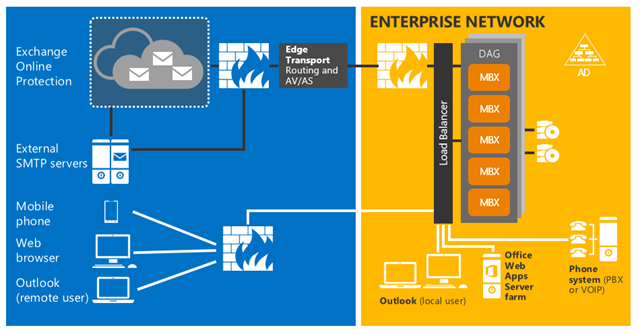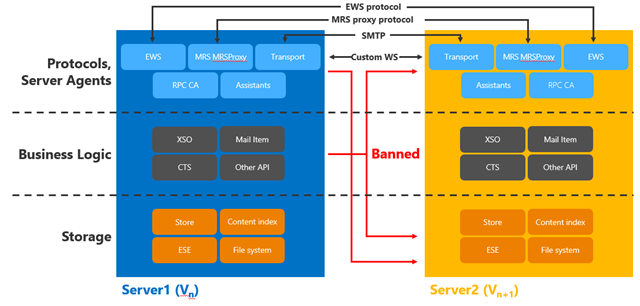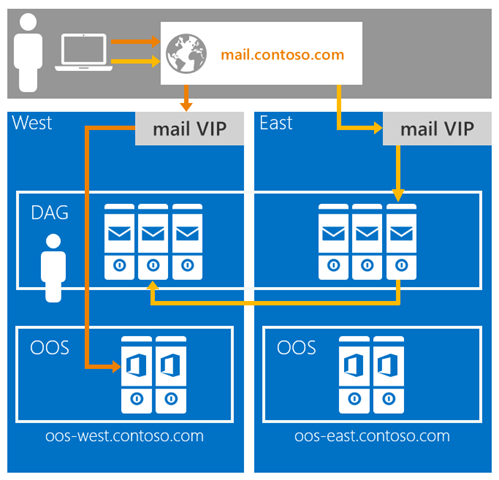Exchange Server 2016 builds upon the architecture introduced in Exchange Server 2013, with the continued focus goal of improving the architecture to serve the needs of deployments at all scales.
Building Block Architecture
In Exchange Server 2016, there is a single building block that provides the client access services and the high availability architecture necessary for any enterprise messaging environment. Figure 1: Building Block Architecture
In our continuing quest to improve the product’s capabilities and simplify the architecture and its deployment, we have removed the Client Access server (CAS) role and added the client access services to the Mailbox role. Even without the CAS role, the system maintains loose coupling in terms of functionality, versioning, user partitioning and geographical affinity.
The Mailbox server role now:
Figure 1: Building Block Architecture
In our continuing quest to improve the product’s capabilities and simplify the architecture and its deployment, we have removed the Client Access server (CAS) role and added the client access services to the Mailbox role. Even without the CAS role, the system maintains loose coupling in terms of functionality, versioning, user partitioning and geographical affinity.
The Mailbox server role now:
- Houses the logic to route protocol requests to the correct destination endpoint.
- Hosts all of the components and/or protocols that process, render and store the data.
- DatabaseAvailabilityGroupIpAddresses is no longer required when creating a DAG. By default, the failover cluster will be created without an administrative access point, as this is the recommended best practice.
- Replay Lag Manager is enabled by default. (released in CU1)
- Lagged database copy play down can be delayed based on disk latency, thereby ensuring active users are not impacted. (released in CU1)
- Database failovers times are reduced by 33% when compared to Exchange Server 2013. (released in CU3)
 Figure 2: Inter-server communication in Exchange 2016
The load balancer configuration is also not affected by this architectural change. From a protocol perspective, the following will happen:
Figure 2: Inter-server communication in Exchange 2016
The load balancer configuration is also not affected by this architectural change. From a protocol perspective, the following will happen:
- A client resolves the namespace to a load balanced virtual IP address.
- The load balancer assigns the session to a Mailbox server in the load balanced pool.
- The Mailbox server authenticates the request and performs a service discovery by accessing Active Directory to retrieve the following information:
- Mailbox version (for this discussion, we will assume an Exchange 2016 mailbox)
- Mailbox location information (e.g., database information, ExternalURL values, etc.)
- The Mailbox server makes the decision to proxy the request or redirect the request to another Mailbox server in the infrastructure (within the same forest).
- The Mailbox server queries an Active Manager instance that is responsible for the database to determine which Mailbox server is hosting the active copy.
- The Mailbox server proxies the request to the Mailbox server hosting the active copy.
 Figure 3: Client Protocol Connectivity
Now many of you may be thinking, wait how does authentication work? Well for HTTP, POP, or IMAP requests that use basic, NTLM, or Kerberos authentication, the authentication request is passed as part of the HTTP payload, so the Client Access services within each MBX server will authenticate the request naturally. Forms-based authentication (FBA) is different. FBA was one of the reasons why session affinity was required for OWA in previous releases of Exchange – the reason being that that the cookie used a per server key for encryption; so if another MBX received a request, it could not decrypt the session. With Exchange 2013, we stopped leveraging a per server session key and instead leveraged the private key from the certificate that was installed on the Client Access server. With Exchange 2016, we now leverage the organization certificate that is configured for the organization’s authorization configuration. This means that any Exchange 2016 server can decrypt the cookie.
And yes, the Edge Transport server role will ship in Exchange Server 2016 (and at RTM, to boot!). All the capabilities and features you had in the Edge Transport server role in Exchange Server 2013, remain in Exchange Server 2016.
Figure 3: Client Protocol Connectivity
Now many of you may be thinking, wait how does authentication work? Well for HTTP, POP, or IMAP requests that use basic, NTLM, or Kerberos authentication, the authentication request is passed as part of the HTTP payload, so the Client Access services within each MBX server will authenticate the request naturally. Forms-based authentication (FBA) is different. FBA was one of the reasons why session affinity was required for OWA in previous releases of Exchange – the reason being that that the cookie used a per server key for encryption; so if another MBX received a request, it could not decrypt the session. With Exchange 2013, we stopped leveraging a per server session key and instead leveraged the private key from the certificate that was installed on the Client Access server. With Exchange 2016, we now leverage the organization certificate that is configured for the organization’s authorization configuration. This means that any Exchange 2016 server can decrypt the cookie.
And yes, the Edge Transport server role will ship in Exchange Server 2016 (and at RTM, to boot!). All the capabilities and features you had in the Edge Transport server role in Exchange Server 2013, remain in Exchange Server 2016.
Why did we remove the Client Access server role?
The Exchange Server 2016 architecture evolves the building block architecture that has been refined over the course of the last several releases. With this architecture, all servers in the Exchange environment (excluding Edge Transport) are exactly the same—the same hardware, the same configuration, and so forth. This uniformity simplifies ordering the hardware, as well as performing maintenance and management of the servers. As with Exchange 2010 and in Exchange 2013, we continue to recommend role co-location as a best practice. From a cost perspective, the overall goal is to ensure that the architecture is balanced for CPU and disk. Having separate server roles can result in long-term cost disadvantages as you may purchase more CPU, disk, and memory resources than you will actually use. For example, consider a server that hosts only the Client Access server role. Many servers enable you to add a given number of disks in a very economical fashion—when you are deploying and using that number of disks, the cost is essentially zero. But if you deploy a server role that uses far less than the given number of disks, you’re paying for a disk controller that is either under-used or not used at all. This architecture is designed to enable you to have fewer physical Exchange servers in your environment. Fewer physical servers mean lower costs for a variety of reasons:- Operational costs are almost always higher than the capital costs. It costs more to manage a server over its lifetime than it does to purchase it.
- You purchase fewer Exchange server licenses. This architecture only requires a license for one Exchange server and one operating system, while breaking out the roles required multiple Exchange server licenses and multiple operating system licenses.
- Deploying fewer servers has a trickle-down effect across the rest of the infrastructure. For example, deploying fewer physical servers may reduce the total rack and floor space required for the Exchange infrastructure, which in turn reduces power and cooling costs.
- You’re distributing the load across a greater number of physical machines, which increases scalability. During a failure event, the load on the remaining servers only increases incrementally, which ensures the other functions the server is performing aren’t adversely affected.
- The solution can survive a greater number of Client Access role (or service) failures and still provide service, which increases resiliency.
Key Architectural Improvements
Exchange Server 2016 also includes a number of architectural improvements, beyond the server role consolidation, including search enhancements, document collaboration improvements, and more.Search Improvements
(Released in CU3): One of the challenging areas for on-premises environment was the amount of data that was replicated with each database copy in previous releases. In Exchange Server 2016, we have reduced bandwidth requirements between the active copy and a passive HA copy; to determine the bandwidth savings for your deployment configuration, you can leverage the Exchange Server Role Requirements Calculator. This was accomplished by enabling the local search instance to read data from its local database copy. As a result of this change, passive HA search instances no longer need to coordinate with their active counterparts in order to perform index updates. Another area of investment in search has been around decreasing the length of time to return search results, especially in online mode clients like OWA. This is accomplished by performing multiple asynchronous disk reads prior to the user completing the search term, which populates the cache with the relevant information, providing sub-second search query latency for online mode clients.Document Collaboration
In previous releases of Exchange, OWA included document preview for Office and PDF documents, reducing the need to have a full fidelity client. SharePoint 2013 had a similar feature, however it used the Office Web Apps Server 2013 (now rebranded as Office Online Server) to accomplish this capability. Within Office 365, we also leverage Office Online Server to provide this capability, ensuring uniform document preview and editing capability across the suite. In Exchange Server 2016, we leverage Office Online Server to provide the rich document preview and editing capabilities for OWA. While this was a necessary change to ensure a homogenous experience across the Office Server suite, this does introduce additional complexity for environments that don’t have Office Online Server. The next generation of Office Online Server will not be supported for co-location with Exchange. Therefore, you must deploy a separate server farm infrastructure. This infrastructure will require unique namespaces, and will require session affinity to be maintained at the load balancer. While Exchange supports an unbound namespace model, the Office Online Server will require a bound namespace for each site resilient datacenter pair. However, unlike the bound namespace model within Exchange, Office Online Server will not require any namespace changes during a datacenter activation. Figure 4: Office Online Server Connectivity
Figure 4: Office Online Server Connectivity
Extensibility
(scheduled for a future CU): Office 365 introduced the REST APIs (Mail, Calendar, and Contact APIs), and now these APIs are available in Exchange Server 2016. The REST APIs simplify programming against Exchange by providing a familiar syntax that is designed with openness (e.g., open standards support JSON, OAUTH, ODATA) and flexibility (e.g., granular, tightly scoped permission to access user data). These APIs allow developers to connect from any platform, whether it be web, PC, or mobile. SDKs exist for.NET, iOS, Android, NodeJS, Ruby, Python, Cordova, and CORS for use in single page JavaScript web apps. What about Exchange Web Services (EWS)? All existing applications that leverage EWS will continue to work with Exchange Server 2016. We are, however, focusing new platform investments on the REST APIs and the apps for Office extensibility model. We expect to make significantly fewer investments in EWS so that we can focus our resources on investing in a single modern API that will, over time, enable most of the scenarios that our partners currently use EWS.Outlook Connectivity
Introduced in Exchange Server 2013 Service Pack 1, MAPI/HTTP is the new standard in connectivity for Outlook. In Exchange Server 2016, MAPI/HTTP is enabled by default. In addition, Exchange Server 2016 introduces per-user control over this connectivity model, as well as, the ability to control whether the protocol (and Outlook Anywhere) is advertised to external clients.Note: Exchange Server 2016 does not support connectivity via the MAPI/CDO library. Third-party products (and custom in-house developed solutions) need to move to Exchange Web Services (EWS) or the REST APIs to access Exchange data.
Coexistence with Exchange Server 2013
In Exchange Server 2013, the Client Access server role is simply an intelligent proxy that performs no processing/rendering of the content. That architectural tenet paid off in terms of forward coexistence. When you introduce Exchange Server 2016, you do not need to move the namespace. That’s right, the Exchange Server 2013 Client Access infrastructure can proxy the mailbox requests to the Exchange 2016 servers hosting the active database copy! For the first time ever, you get to decide when you move the namespace over to the new version. And not only that, you can even have load balancer pools contain a mix of Exchange Server 2013 and Exchange Server 2016. This means you can do a one-for-one swap in the load balancer pool – as you add Exchange 2016 servers, you can remove Exchange 2013 servers.Topology Requirements
Exchange Server 2016 will only be supported on Windows Server 2012, Windows Server 2012 R2 and Windows Server 2016 operating systems. From an Active Directory perspective, Exchange Server 2016 will require:- Windows Server 2008 or later Active Directory servers.
- Windows Server 2008 or higher Forest Functional Mode and Domain Functional Mode.
The Preferred Architecture
During my session at Microsoft Ignite, I revealed Microsoft’s preferred architecture (PA) for Exchange Server 2016. The PA is the Exchange Engineering Team’s best practice recommendation for what we believe is the optimum deployment architecture for Exchange 2016, and one that is very similar to what we deploy in Office 365.While Exchange 2016 offers a wide variety of architectural choices for on-premises deployments, this architecture is our most scrutinized one ever. While there are other supported deployment architectures, they are not recommended.
The Exchange 2016 PA is very similar to the Exchange 2013 PA. A symmetrical DAG is deployed across a datacenter pair with active database copies distributed across all physical servers in the DAG. Database copies are deployed on JBOD storage, with four copies per-disk. One of the copies is a lagged database copy. Clients connect to a unified namespace that is equally distributed across the datacenters in the site resilient pair. However, the Exchange 2016 PA differs in the following ways:- Exchange’s unbound namespace model is load balanced across the datacenters in a layer 7 configuration that does not leverage session affinity.
- An Office Online Server farm is deployed in each datacenter, with each farm having a unique namespace (bound model). Session affinity is managed by the load balancer.
- The DAG is deployed without an administrative access point.
- The commodity dual-socket server hardware platform contains 20-24 cores and up to 96GB of memory, and a battery-backed write cache controller.
- All data volumes are formatted with ReFS (with the integrity feature disabled).
Summary
Exchange Server 2016 continues in the investments introduced in previous versions of Exchange by reducing the server role architecture complexity, aligning with the Preferred Architecture and Office 365 design principles, and improving coexistence with Exchange Server 2013. These changes simplify your Exchange deployment, without decreasing the availability or the resiliency of the deployment. And in some scenarios, when compared to previous generations, the PA increases availability and resiliency of your deployment. Ross Smith IV Principal Program Manager Office 365 Customer ExperienceUpdates
- 5/8/15: Added section on topology requirements.
- 7/8/15: Updated topology requirements.
- 10/1/15: Updated for RTM.
- 10/12/15: Added Preferred Architecture link.
- 3/15/16: Updated with deferred play down support in CU1.
- 9/21/16: Updated with read from passive support in CU3.
Updated Jul 01, 2019
Version 2.0Ross Smith IV
Former Employee
Joined August 07, 2017
Exchange Team Blog
You Had Me at EHLO.